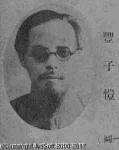Feng Zikai
Feng Zikai
เกิด: 1898
ความตาย: 1975
ชีวประวัติ:
Feng Zikai (November 9, 1898 – September 15, 1975) was an influential Chinese painter, pioneering manhua (漫画) artist, essayist, and lay Buddhist of twentieth century China. Born just after the First Sino-Japanese War (1894-1895) and passing away just before the end of the Cultural Revolution (1966-1976), he lived through much of the political and socio-economic turmoil that arose during the birth of Modern China. Much of his literary and artistic work comments on and records the relationship between the changing political landscape and the daily lives of ordinary people. Although he is most famous for his paintings depicting children and the multi-volume collection of Buddhist-inspired art, Paintings for the Preservation of Life (护生画集), Feng Zikai was a prolific artist, writer, and intellectual, who made strides in the fields of music, art, literature, philosophy, and translation.
A native of Shimenwan (石门湾) in Chongde county, Zhejiang Province, Feng Zikai went to school from an early age, the only son and youngest of eight children of a relatively wealthy and educated family. Although the Feng family owned a dye shop, a business made somewhat profitable due to the great number of waterways and trade networks that passed through Shimenwan. Shimenwan lay between Hangzhou and Suzhou, which connected this small rural town to the bigger metropolitans of Beijing and Shanghai. Despite this, Feng Zikai’s father mostly ignored the dye shop, preferring to study endlessly for the civil service exams in Hangzhou that still mostly dictated one’s ability to rise on economic ladder. Ignoring the family business like his father, but also not showing interest in a traditional Confucian education, Feng Zikai’s fascination with art began when he was but a child. Feng Zikai’s father finally passed the provincial exams in 1902, but shortly after that, Feng Zikai’s grandmother passed away, initiating the traditional three-year mourning period for Feng Zikai’s father. During that period however, by 1905, the civil service exams system was abolished. With no path left for him to take the final exams in Beijing, Feng Zikai’s father spent his time drinking, smoking opium, and tutoring his only son. This focus on Feng Zikai, obviously a by-product of being the sole male heir of the family, led to him being a stubborn and strong-willed child. He was doted upon by the townspeople, most likely due to his father’s mild reputation for passing the provincial exams, and was referred to as 'young master' (少爷) by the townspeople. This stubbornness manifested in Zikai’s determination to pursue his own interests, most notably drawing and paintings. Often shirking his lessons with his father, Feng Zikai was captivated by the illustrations and woodblock prints found in his father’s Confucian classics. Feng Zikai frequently stole pigments and dyes from the family stole and colored in many of the illustrations, earning him the scolding and punishment from his father who remained unimpressed with his son's illustrations. Shortly after his father’s death from tuberculosis in 1906, Feng Zikai happened upon a book of figures, and practice tracing and drawing figures, using the book as his guide and reference. He continued to pursue his obsession with tracing figures all throughout elementary school, earning a growing reputation as the “Little Artist”.
In 1914, Feng Zikai travelled to Hangzhou to enroll in the Zhejiang First Normal School (now Hangzhou High School), where his career in art truly took off. The school aspired to manifest the new educational values of the Republic of China, and boasted the highest level funding of any provincial school at the time. Many great artistic and literary figures of twentieth century China were educated here, such as Pan Tianshou, Lu Xun, Ye Shengtao and Xia Miazun. Like many other parents, Feng's mother, recognizing his budding literary talent, encouraged him to attend a school that offered a degree in the humanities in hopes of him becoming a man of letters. This education would prepare to become a teacher and give him a solid training in the Chinese Classics. In line with traditional social expectations and standards, a career pursuing education and literature was preferable to most anything else, but especially one of trade. Furthermore, she wished to see Feng Zikai following in his father’s footsteps, still hoping that the civil service examinations would be reinstated. He entered the school with aspirations to become a teacher, but as fate would have it, the school, led by principal Jing Hengyi (1877 – 1939), emphasized moral and artistic education. The school particularly espoused Neo-Confucian ethics and social duties as well, as they strived to instill within the students a sense of civic duty. Jing Hengyi and his family had been advocates of educational and political reform, and his leadership soon attracted a cohort of talented and devoted students and faculty, including many literary and artistic figures who would become quite renowned. The core philosophy of the school was moral education, encouraging and training students to be the new vanguard of social reformers.
More...


